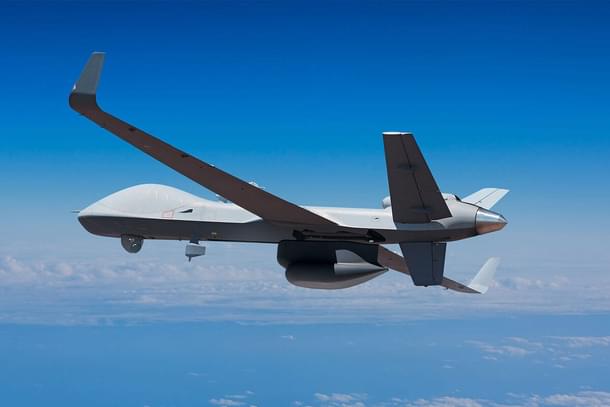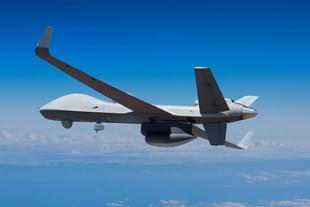Defence
Five Misleading Claims Made By The Congress On India-US Deal For MQ-9B Drones
Swarajya Staff
Jun 29, 2023, 11:20 AM | Updated 11:35 AM IST
Save & read from anywhere!
Bookmark stories for easy access on any device or the Swarajya app.


The Congress on Wednesday (28 June) questioned the government regarding the cost of acquiring the 31 MQ-9B drones that India is purchasing from the United States, claiming that countries like the United Kingdom and Germany have paid significantly less than what India would have to spend.
While the government has clarified that the unit cost of the drones is still being negotiated, the Congress has disregarded this argument.
"The AoN [Acceptance of Necessity] noted the estimated cost of $3,072 million provided by the US Government. However, the price will be negotiated once policy approval from the US Government is received," the government said in a statement last week.
However, the Congress continues to criticise Prime Minister Narendra Modi over the deal. It has raised several questions in its latest move on the issue. Many of its claims, however, do not withstand scrutiny.
Apart from its claim that India is paying the "highest price" for the drones, here are four misleading assertions made by the Congress.
Claim 1: India is buying 'outdated drones'.
One of the most bizarre claims made by the Congress is that the drones India is buying under this deal with the US are "outdated".
Experts, however, have dismissed this claim, with many saying the drones will give India capability which both its adversaries, Pakistan and China, do not have currently.
While the Chinese have developed a number of drones indigenously and Pakistan has obtained some from its allies in Ankara, the two countries are yet to field any, which outmatch the MQ-9B unmanned aerial vehicles that the Indian Armed Forces would get.
"MQ-9B is the newest in a family of systems that has achieved over 7 million flight hours supporting operations around the globe," General Atomics (GA), the maker of these drones, says.
The claim is further discredited by the fact that the United Kingdom signed a deal for MQ-9B drones only three years ago, in 2020.
Claim 2: DRDO's Rustom-II (Tapas-BH) project costs "only 10-20 per cent" of the cost of the MQ-9 drones.
The party claims that India's indigenous drone programme costs only a fraction of the money being spent in buying the MQ-9 drones.
One, the comparison is flawed because the party is comparing the cost of development of the Tapas platform to the cost of aquiring 31 MQ-9 drones along with the spares and weapons required to operate and sustain them.
Two, the capabilities of the two platforms in question are very different, and despite the progress made by the indigenous drone programme in recent months, India is years away from developing a UAV that comes close in terms of the capabilities to the MQ-9s bring to the table.
"Tapas-BH is a MALE UAV with an operating altitude of 30,000 feet" and "endurance of 24 hours," the DRDO website says, adding that it can "carry a variety of payloads up to a maximum of 350 kg."
In comparison, the MQ-9B is "designed to fly over the horizon via satellite for up to 40 hours" and "the aircraft features nine external hardpoints (8 wing, 1 centerline) that carry up to 4,750 lbs (2,155 kg)" of payload.
Claim 3: The military's requirement is only 18 units.
If one believes the claim made by the Congress, it would be perhaps the first time that an Indian government is providing the military with more resources than it actually needs. It is certainly the first time it is being accused of doing so.
With the 'LoCisation' of the Line of Actual Control — the deployment of heavy equipment and over 50,000 troops — following the ongoing standoff in eastern Ladakh and China's rapidly expanding footprint in the Indian Ocean, it is highly unlikely that the Indian military wouldn't find use for 31 MQ-9 drones, some of which would be capable of carrying arms.
Pakistan has recently acquired dozens of armed drones from Turkey, and the Chinese have deployed their fleet of lates drones along the LAC.
Claim 4: MQ-9B purchase is a "big blow to Make-In-India in defence"
This claim is misleading for multiple reasons.
First, India's indigenous drone program, including the Tapas-BH, continues to make progress, as reported by Swarajya earlier this year.
Second, the MQ-9 drones purchased from the US will be assembled in India, leading to the creation of expertise and infrastructure necessary for manufacturing such drones within the country. This will accelerate the future induction of indigenous drones.
Third, the Indian Ministry of Defence is working on negotiating a deal with General Atomics to increase the indigenous content in the MQ-9 UAVs.
This would result in the development of a supply chain in India and the absorption of new critical defense technologies by the Indian defense industry, thereby expediting the indigenous drone program.
Fourth, in addition to the Hellfire missiles bought from the US for these drones, Indian weapons will also be integrated with the MQ-9s, resulting in more orders for the domestic industry.
Fifth, as part of the deal, Maintenance, Repair, and Overhaul (MRO) infrastructure for the drones, including the turbo-propeller engines that power the drones, will be established in India with support from GA.




